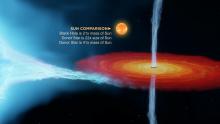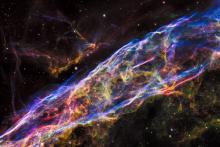Listen to today's episode of StarDate on the web the same day it airs in high-quality streaming audio without any extra ads or announcements. Choose a $8 one-month pass, or listen every day for a year for just $30.
You are here
Beginning of the End
A star that’s at the beginning of its final act is going out in style. It’s blowing hot gas off its surface, forming clouds on either side of the star. Powerful winds from the star are sculpting both clouds into cones, with the wide ends closer to the star.
The star doesn’t have a name — only a long list of numbers. But the entire complex is nicknamed Minkowski’s Footprint, after the astronomer who cataloged it, and its resemblance to a footprint in some images.
The star is bigger, brighter, and more massive than the Sun. But it’s burned through the nuclear fuel in its core, so the fusion reactions that power it are shutting down. That’s causing the star’s outer layers to surge out into space, creating a nebula around the star.
This process is in its early days, so it’s known as a protoplanetary nebula. The nebula is visible only because its gas and dust reflect light from the star. But in a few thousand years, the dying core will become much hotter. Its radiation will cause the clouds to glow on their own, creating a full-fledged planetary nebula.
The expelled material will continue to expand, forming a colorful bubble. After tens of thousands of years, it’ll fade from view, and only the hot but dead core will remain — the end of a star.
The nebula is near the beak of Cygnus, the swan, which is about a third of the way up the western sky at nightfall. But you need a telescope to see this dying star.
Script by Damond Benningfield





